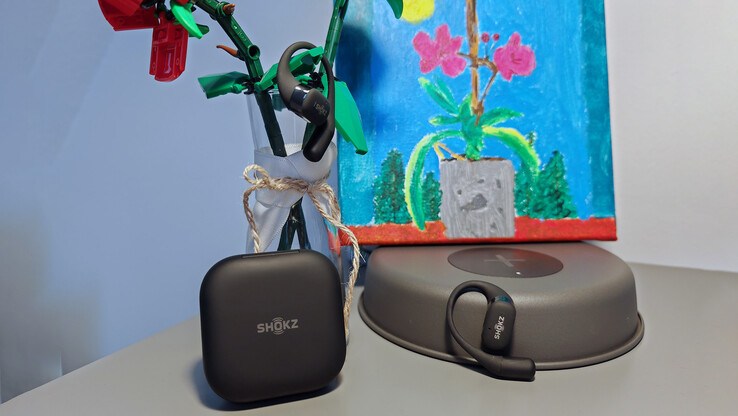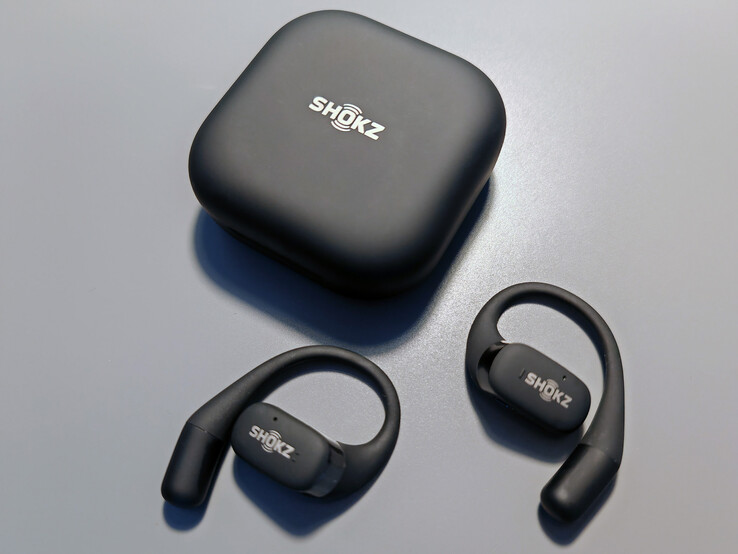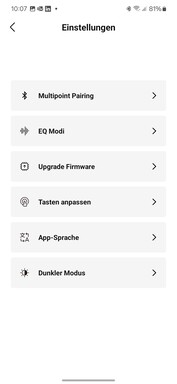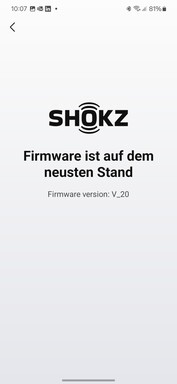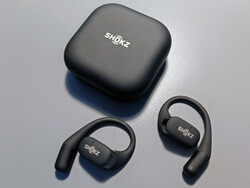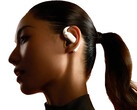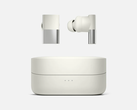Shokz OpenFit in review - Lightweight true wireless headset with a good sound
The Shokz OpenFit are among the few true wireless headphones (TWS) that use an open-ear design and do not require inserting into the ear canal. As a result, they occupy a niche in the category while still wishing to be ideal for sports, provide a comfortable fit, and offer an outstanding sound.
We'll see if Shokz (previously AfterShokz) can meet its promises in this test.
Specifications
| Wearing style | Earhook, open-ear |
| Connectivity | Bluetooth 5.2, dual connectivity |
| Range | ~ 33 ft |
| Speaker | Air Conduction Transducer, 50 - 16,000 Hz, 96 dB ± 2.5 dB |
| Audio-Codecs | SBC, AAC |
| Battery capacity | 58 mAh (earphones), 600 mAh (charging case) |
| Charging port | USB-C |
| Wireless charging | No |
| Weight | 0.30 oz (earphones), 2 oz (charging case) |
| Firmware version | V_20 |
| Delivery contents | Headphones, charging case, charging cable (USB-A to USB-C), documentation |
| Price (RRP) | ~US$180 |
Casing and ergonomics - Shokz OpenFit barely noticeable
At 0.30 oz per earbud, the Shokz OpenFit is comparatively heavy. In comparison, the Huawei FreeBuds 5 weighs just 0.19 oz. The significant difference lies in the fact that the Shokz TWS doesn't need to be inserted into the ear canal or held in the tragus; instead, they use an ear hook, making them feather-light. The wearing comfort is excellent, often requiring us to check whether the headphones are still in place. Even during intense physical activity or sports, they remain firmly in position.
The OpenFit is made of plastic and silicone and has a pleasant feel to it. The exquisite production assures stability without any unpleasant edges or corners. The charging case, on the other hand, is rather bulky, and the matte plastic is easily fingerprinted.
While the Shokz OpenFit earbuds have an IP54 certification, indicating protection against damaging amounts of dust and splashing water from all sides, the charging case lacks this certification.
Features and operation - No ANC for the Shokz-TWS
The Shokz OpenFit focuses on the essentials, offering neither active noise cancellation (ANC) nor HearThrough. The latter is not necessary, as the headphones consistently allow for good environmental awareness, not passively shielding the ear.
The multipoint pairing mentioned by Shokz involves dual Bluetooth, enabling the connection of up to two devices simultaneously. Depending on requirements, the headphones switch between them automatically, or manual switching can be done via the app. Unfortunately, the pairing list can only include these two devices.
The corresponding app is available on Google Play, the Apple App Store, Samsung's Galaxy Store, and the Huawei AppGallery. Firmware updates can be downloaded, and equalizers can be defined if required.
The buttons on the earphones felt through discreet silicone nipples, respond reliably and are primarily responsible for media playback. They can also be used to answer or end calls, and initiate the predefined voice assistant on the smartphone.
Sound - Powerful mids and real bass
Upon initially wearing the Shokz OpenFit, we were pleasantly surprised by their rich sound and wide stage, since we hadn't anticipated such a feature in this particular area. Even the lower mids and bass frequencies are clearly audible, according to the pink noise measurement. In the extremely high frequencies, the Shokz headphones only become slightly less powerful. However, the OpenFit makes an excellent impact whether playing music or movies.
A microphone is also embedded into each earbud, allowing for a reasonable conversation experience in quiet locations. In the test, however, they demonstrated to be vulnerable to wind, and even on a moderate bike ride, making a phone call was out of the question.
| Loudspeakers | |
| THD | |
| Shokz OpenFit (RMS: -1.5 dBFS) | |
| Jabra Elite 5 (RMS: -2.9 dBFS) | |
| Huawei FreeBuds 5 (RMS: -2.8 dBFS) | |
| THD+N | |
| Shokz OpenFit (RMS: -1.5 dBFS) | |
| Jabra Elite 5 (RMS: -2.9 dBFS) | |
| Huawei FreeBuds 5 (RMS: -2.8 dBFS) | |
* ... smaller is better
THD (Total Harmonic Distortion): Harmonic distortion quantifies the distortion caused by non-linear components (harmonic content) in relation to the original signal. THD specifically refers to the fundamental component. It's important to note that while the term "distortion factor" is often used interchangeably, it actually refers to the overall signal, not just the fundamental component.
THD+N (Total Harmonic Distortion + Noise): This value is comparable to THD, but in addition to measuring the interference power of harmonics, it also takes into account the impact of noise as an effective value. For the measurement, a low harmonic sinusoidal signal (typically at 1 kHz and > 0 dB) is played back through the headphones under test. This signal is then recorded by a linear measuring microphone (placed at a measuring distance of approximately 0.40 inches) in an artificial head.
Both THD and THD+N values are expressed as percentages. The lower the value, the higher the fidelity of the signal.
Shokz OpenFit audio analysis
(+) | speakers can play relatively loud (90.8 dB)
Bass 100 - 315 Hz
(+) | good bass - only 4.8% away from median
(+) | bass is linear (2.9% delta to prev. frequency)
Mids 400 - 2000 Hz
(+) | balanced mids - only 1.7% away from median
(+) | mids are linear (1.6% delta to prev. frequency)
Highs 2 - 16 kHz
(±) | higher highs - on average 6.5% higher than median
(+) | highs are linear (6.7% delta to prev. frequency)
Overall 100 - 16.000 Hz
(+) | overall sound is linear (9.6% difference to median)
Compared to same class
» 4% of all tested devices in this class were better, 1% similar, 96% worse
» The best had a delta of 4%, average was 24%, worst was 134%
Compared to all devices tested
» 4% of all tested devices were better, 1% similar, 96% worse
» The best had a delta of 4%, average was 24%, worst was 134%
Huawei FreeBuds 5 audio analysis
(+) | speakers can play relatively loud (87 dB)
Bass 100 - 315 Hz
(±) | reduced bass - on average 8.4% lower than median
(+) | bass is linear (2.1% delta to prev. frequency)
Mids 400 - 2000 Hz
(±) | reduced mids - on average 5.7% lower than median
(+) | mids are linear (5.3% delta to prev. frequency)
Highs 2 - 16 kHz
(-) | very high highs - on average 15.4% higher than median
(+) | highs are linear (4.8% delta to prev. frequency)
Overall 100 - 16.000 Hz
(±) | linearity of overall sound is average (20.4% difference to median)
Compared to same class
» 53% of all tested devices in this class were better, 8% similar, 39% worse
» The best had a delta of 4%, average was 24%, worst was 134%
Compared to all devices tested
» 53% of all tested devices were better, 8% similar, 39% worse
» The best had a delta of 4%, average was 24%, worst was 134%
Battery life - Over seven hours on one charge
The Shokz OpenFit has quite large batteries with 58 mAh per earbud, but certainly also benefits from the fact that they do not have ANC in the runtime test. As a result, they exceed the competition with ANC.
With a capacity of 600 mAh, the charging case theoretically offers more than five additional charges, however, Shokz only mentions four. A fully charged case may be recharged in two hours via USB-C; wireless charging is not supported. The individual earphones are fully charged in the casing within an hour, but five minutes of charging should be enough to enable one hour of media playback.
| Battery Runtime - Spotify loop at 65dB/A (incl ANC) | |
| Shokz OpenFit | |
| Jabra Elite 5 | |
| Huawei FreeBuds 5 | |
Verdict - Shokz makes a strong TWS debut
The Shokz OpenFit performed admirably during testing, with a comfortable fit, extended battery life, and a rich sound. The open-ear design, which is uncommon, combined with ear hooks guarantees a secure fit during vigorous activity, minimizing concerns about them slipping off.
Although the Shokz OpenFit has excellent audio quality, a long battery life, and wearing comfort, there are a few technological flaws.
Although the IP54 rating is impressive for shielding the headphones from dust and water splashes, they are not completely waterproof. Notable downsides include the charging case's inability to enable wireless charging and the absence of active noise reduction. Positively, the dual connection capability helps; nonetheless, the pairing list's restriction to two devices is a drawback. It was discovered during the test that the microphones were highly vulnerable to wind interference.
If you appreciate great sound quality and a secure fit, the Shokz OpenFit is a good option. Those who frequently make phone calls or appreciate active noise cancellation (ANC) should take a closer look at the FreeBuds 5. If money is an issue, the Sennheiser CX True Wireless or Galaxy Buds2 Pro are more affordable in-ear options.
Price and Availability
The Shokz OpenFit may be purchased straight from the company's website, however Amazon and Cyberport offer them at lower prices.
Transparency
The selection of devices to be reviewed is made by our editorial team. The test sample was given to the author by the manufacturer free of charge for the purposes of review. There was no third-party influence on this review, nor did the manufacturer receive a copy of this review before publication. There was no obligation to publish this review. As an independent media company, Notebookcheck is not subjected to the authority of manufacturers, retailers or publishers.
This is how Notebookcheck is testing
Every year, Notebookcheck independently reviews hundreds of laptops and smartphones using standardized procedures to ensure that all results are comparable. We have continuously developed our test methods for around 20 years and set industry standards in the process. In our test labs, high-quality measuring equipment is utilized by experienced technicians and editors. These tests involve a multi-stage validation process. Our complex rating system is based on hundreds of well-founded measurements and benchmarks, which maintains objectivity. Further information on our test methods can be found here.


